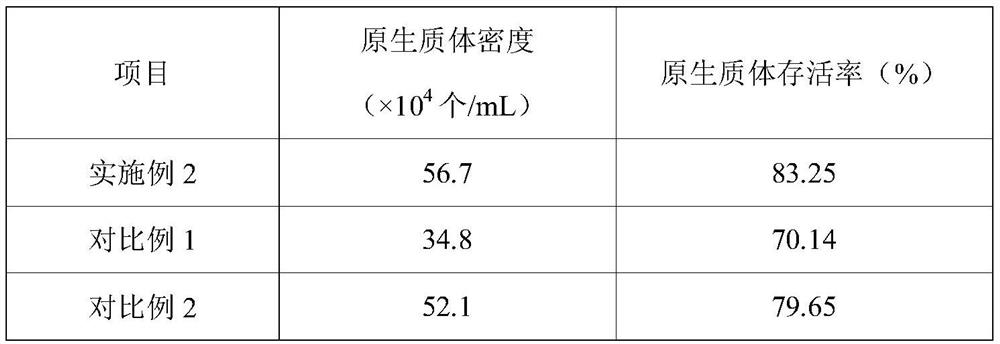Method for separating and culturing seaweed protoplasts and regenerating plants
A technology for protoplasts and regenerated plants, applied in botany equipment and methods, plant regeneration, horticultural methods, etc., can solve the problems of short seedling cultivation period, achieve the effect of increasing division frequency, increasing cell division speed and maintaining stability
- Summary
- Abstract
- Description
- Claims
- Application Information
AI Technical Summary
Problems solved by technology
Method used
Image
Examples
Embodiment 1
[0023] Seaweed species choose Eucheuma.
[0024] The method for separating and cultivating seaweed protoplasts and regenerating plants is mainly based on the totipotency of seaweed somatic cell development, using seaweed tool enzymes to decompose seaweed tissues, freeing somatic cell protoplasts, obtaining somatic cells and cell lines that regenerate cell walls, and then Regenerated plants were obtained by culturing. Specific steps are as follows:
[0025] (1) Select algal bodies with normal color, no rot, and vigorous growth, use a brush to clean up the sludge, algae and other subsidiary impurities on the surface of the algae, and use 0.005% HgCl 2 The solution was sterilized for 5 seconds, then rinsed with sterilized seawater, cut off the young part of the top of the fresh algae, blotted the surface moisture with filter paper, cut or ground it into small tissue pieces or small branches, and firstly mixed potassium sodium tartrate and After soaking in the PVP mixed solution...
Embodiment 2
[0034] Seaweed algae species choose red leek.
[0035] The method for separating and cultivating seaweed protoplasts and regenerating plants is mainly based on the totipotency of seaweed somatic cell development, using seaweed tool enzymes to decompose seaweed tissues, freeing somatic cell protoplasts, obtaining somatic cells and cell lines that regenerate cell walls, and then Regenerated plants were obtained by cultivation. Specific steps are as follows:
[0036] (1) Select algal bodies with normal color, no rot, and vigorous growth, use a brush to clean the surface sludge, algae and other subsidiary impurities, and use 0.006% HgCl 2 The solution was sterilized for 6 seconds, then rinsed with sterilized seawater, cut off the tender part of the top of the fresh algae, blotted the surface moisture with filter paper, cut or ground it into small tissue pieces or small branches, and firstly mixed potassium sodium tartrate and After soaking in the PVP mixed solution for 2 hours, ...
Embodiment 3
[0045] Seaweed species choose seaweed.
[0046] The method for separating and cultivating seaweed protoplasts and regenerating plants is mainly based on the totipotency of seaweed somatic cell development, using seaweed tool enzymes to decompose seaweed tissues, freeing somatic cell protoplasts, obtaining somatic cells and cell lines that regenerate cell walls, and then Regenerated plants were obtained by cultivation. Specific steps are as follows:
[0047] (1) Select algae with normal color, no rot, and vigorous growth, use a brush to clean up the sludge, algae and other subsidiary impurities on the surface of the algae, and use 0.008% HgCl 2 The solution was sterilized for 10 seconds, then rinsed with sterilized seawater, cut off the young part of the top of the fresh algae, blotted the surface moisture with filter paper, cut or ground it into small tissue pieces or small branches, and firstly mixed potassium sodium tartrate and After soaking in the PVP mixed solution for ...
PUM
 Login to View More
Login to View More Abstract
Description
Claims
Application Information
 Login to View More
Login to View More - R&D
- Intellectual Property
- Life Sciences
- Materials
- Tech Scout
- Unparalleled Data Quality
- Higher Quality Content
- 60% Fewer Hallucinations
Browse by: Latest US Patents, China's latest patents, Technical Efficacy Thesaurus, Application Domain, Technology Topic, Popular Technical Reports.
© 2025 PatSnap. All rights reserved.Legal|Privacy policy|Modern Slavery Act Transparency Statement|Sitemap|About US| Contact US: help@patsnap.com

